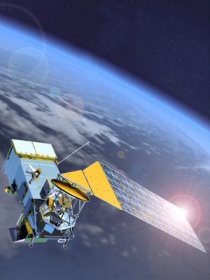Troubled Satellite Program May Leave U.S. Vulnerable
 The United States' program to replace its aging polar satellites is $3 billion over budget, and 3 years behind schedule. Such a delay could severely hinder forecaster's ability to accurately predict where a hurricane makes landfall, Scientific American reported yesterday. Despite their name, polar satellites provide images of almost every spot on the surface of the Earth.
The United States' program to replace its aging polar satellites is $3 billion over budget, and 3 years behind schedule. Such a delay could severely hinder forecaster's ability to accurately predict where a hurricane makes landfall, Scientific American reported yesterday. Despite their name, polar satellites provide images of almost every spot on the surface of the Earth.A Plan To Avoid Duplication
The troubled program was born out of a desire to avoid a duplication of effort. Currently, the National Oceanic and Atmospheric Administration (NOAA) and the Department of Defense (DOD) operate polar satellites. In 1994, it was decided that the agencies would pool their efforts and form the National Polar-orbiting Operational Environmental Satellite System. Under the plan, the agencies would get new satellites with twice the number of instruments, and save $1.8 billion.
Plan A Fails To Fly
In 2002, the joint agency hired Northrop-Grumman to build the satellites. A test satellite was supposed to go up this May. They're now hoping for April, 2009. The first fully functional satellite was supposed to go up in 2008. It's not going to happen, 2012 seems more likely.
What went wrong? Northrop-Grumman blames most of the delays and cost overruns on problems with the orbiters' sensors. The contractor says developing the sensors turned out to be tougher than it thought.
The Government Accountability Office (GAO) found plenty of blame to go around. David Powner of the GAO told congress that both the government and its contractors failed to recognize problems in time to fix them and that the program's executives were too hesitant to make decisions, preferring to conduct more studies.
Plan B
To get the program on track, NOAA, the DOD and NASA have hired a new program manager. Raytheon, the subcontractor working on the sensors, replaced its entire team. NOAA administrator Conrad C. Lautenbacher has suggested eliminating some of the sensors from the satellites to save time and money. But even with the changes, the program would be $1 billion over budget.
Plan C
What if the new satellites don't go up before the old ones wear out? The DOD's satellites can probably survive well beyond 2012. The problem is that they don't provide all the data NOAA needs for its weather forecasting. NASA could help fill the gap with research satellites or high-altitude flights. NOAA has also suggested putting more sensor on the first test satellite. The U.S. might also get data from European satellites, assuming of course that they are available and produce data in a format compatible with U.S. equipment.
Plan D
Until the new, improved satellites get into orbit, NOAA plans to launch the last its original polar satellites in December, 2007. There is some concern whether that satellite will work however. Lockheed Martin, the contractor that built it, accidentally dropped it, causing significant damage.




<< Home